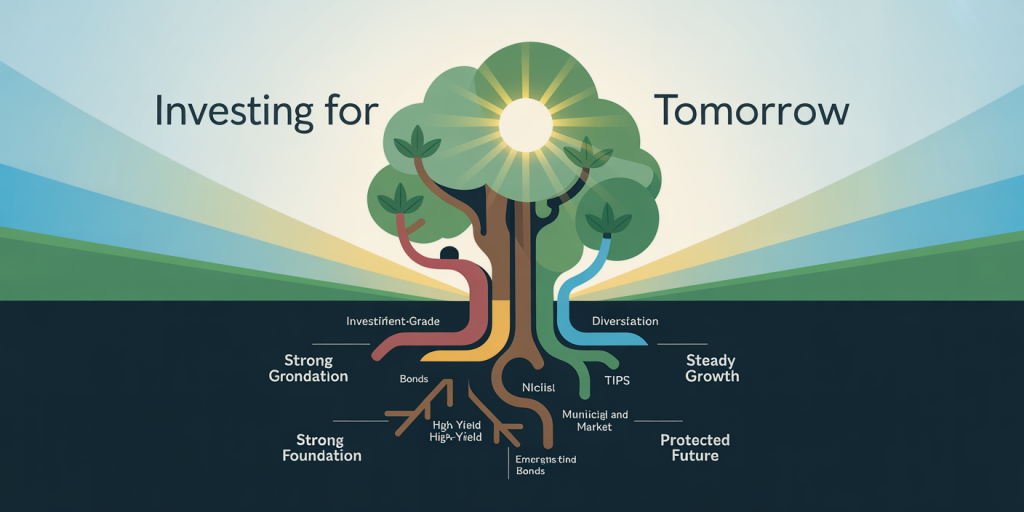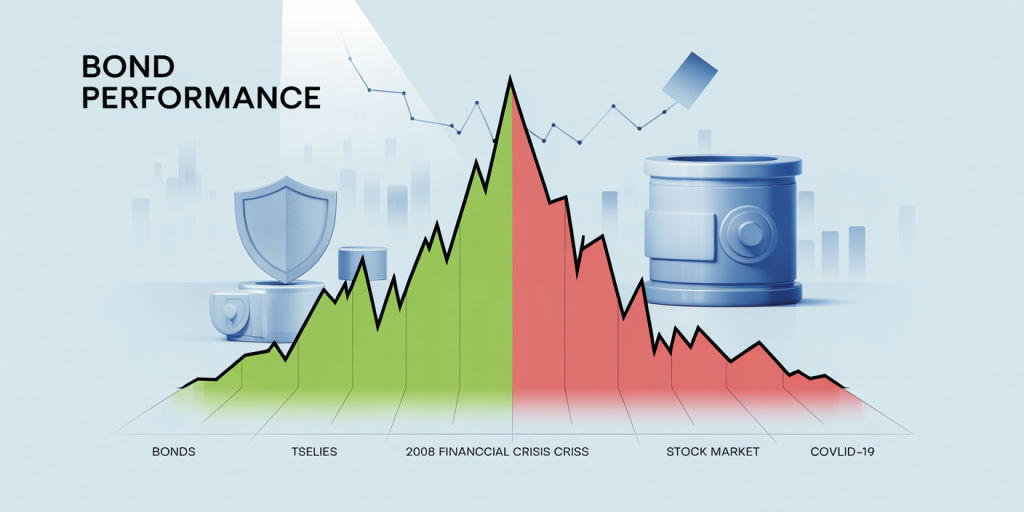The Role of Bonds in a Modern Portfolio: Beyond Just Safety
In the world of investing, bonds have traditionally been viewed primarily as a tool for capital preservation and stability. The classic image of bonds serving as a defensive asset class against the volatility of equities is deeply ingrained among both professional and retail investors. However, in today’s dynamic financial environment, the role of bonds extends far beyond mere safety. They can serve as a multi-faceted component of a well-rounded portfolio—offering diversification, income generation, and even potential growth opportunities, all while adapting to changing market conditions.
This article explores how bonds fit into modern portfolio construction, shedding light on their evolving utility. By examining practical examples, statistical data, and comparative analyses, we aim to provide investors with a comprehensive understanding of the contemporary roles bonds play. This discussion also includes insights into how recent economic events, such as fluctuating interest rates and geopolitical risks, are reshaping strategic approaches involving fixed income securities.
Understanding Bonds: More Than a Safe Haven
Bonds are debt instruments issued by governments, municipalities, or corporations to raise capital, promising periodic interest payments and the return of principal upon maturity. Historically, bonds have acted as a haven during market downturns since their prices tend to be less volatile than stocks. For instance, during the 2008 financial crisis, the Bloomberg Barclays U.S. Aggregate Bond Index delivered positive returns of approximately 5.2%, while the S&P 500 plummeted over 37%.

However, the perception of bonds as mere “safe assets” is increasingly outdated. Bonds come in a variety of types—investment-grade, high-yield, inflation-protected securities, and emerging market debt—each with unique risk-return profiles. In adapting to an environment marked by historically low interest rates and unpredictable inflation, investors must evaluate bonds for their potential beyond the safety they traditionally provide.

A diversified bond allocation can enhance a portfolio’s risk-adjusted returns, as bonds often respond differently to economic factors compared to equities. For example, in inflationary periods, Treasury Inflation-Protected Securities (TIPS) have historically provided better protection than nominal bonds, safeguarding purchasing power while delivering steady income.
Bonds as a Diversification Tool: Spatial and Temporal Benefits
Diversification is a cornerstone of modern portfolio theory, and bonds offer critical diversification benefits by typically exhibiting low or negative correlation with stocks. The correlation coefficient between U.S. investment-grade bonds and equities has historically hovered around 0.2, implying that bonds often move independently or in the opposite direction to stocks. This characteristic can dampen overall portfolio volatility and reduce drawdowns.
Practical evidence of diversification benefits was seen during the COVID-19 market sell-off in early 2020. While U.S. equities witnessed their fastest decline in history, high-quality government bonds posted positive returns as investors sought safe-haven assets. This inverse relationship between stocks and bonds helped cushion portfolio losses and facilitate quicker recovery.
Moreover, time horizon plays a critical role. Investors with longer time horizons can benefit from bond laddering strategies—holding bonds maturing at staggered intervals to manage reinvestment risk and provide steady income streams. A bond ladder can smooth cash flows and reduce sensitivity to interest rate fluctuations, allowing for reinvestment at prevailing rates rather than locking into a single maturity date’s yield.
The below table summarizes the correlation of various asset classes with U.S. equities over the past 20 years:
| Asset Class | Correlation with U.S. Equities |
|---|---|
| U.S. Investment-Grade Bonds | 0.20 |
| High-Yield Bonds | 0.60 |
| Real Estate Investment Trusts (REITs) | 0.70 |
| Commodities | 0.05 |
| Treasury Inflation-Protected Securities (TIPS) | 0.15 |
This data highlights the varying degrees of diversification bonds provide, underscoring the importance of strategically selecting bond types.
Income Generation in a Low-Interest-Rate Environment
One of the most valued roles of bonds is income generation via coupon payments. However, the dramatic decline in yields over the past decade has posed challenges to investors seeking reliable cash flow. For example, the yield on the 10-year U.S. Treasury note fell from around 3.2% in 2018 to below 1.5% by mid-2020.
Despite these headwinds, bonds continue to be an essential income source—especially for retirees and income-focused investors. To enhance yield without excessive risk, many investors have turned to diverse fixed income sectors such as corporate bonds, municipal bonds, and international debt.
High-yield bonds, often called “junk bonds,” offer higher coupons to compensate for increased credit risk. The ICE BofA U.S. High Yield Index posted an average annual yield of 6.3% as of early 2024, compared to approximately 3.5% for the Bloomberg Barclays U.S. Aggregate Bond Index. While higher yield may entail more defaults, active credit analysis can help mitigate these risks and capitalize on income potential.

Municipal bonds present another option, particularly attractive to investors in higher tax brackets. These bonds often offer tax-exempt interest income, which effectively boosts after-tax returns. For example, a 4% yield on a municipal bond may be equivalent to a 6% taxable yield for someone in a 33% tax bracket.
In practice, investors considering bond income should diversify across sectors and maturities to balance risks and returns. Incorporating inflation-protected securities like TIPS can add a layer of protection against eroding purchasing power, aligning income streams with rising prices.
Bonds as a Hedge Against Inflation and Interest Rate Risks
The bond market is sensitive to inflation and interest rates, factors that directly influence bond prices and yields. Traditional wisdom cautions that bonds lose value when interest rates rise since newer bonds offer higher coupons, making existing bonds less attractive. This sensitivity is measured by duration—longer-duration bonds tend to have more pronounced price swings.
Nonetheless, certain bond strategies can hedge against these risks. For instance, Treasury Inflation-Protected Securities adjust their principal based on inflation, shielding investors from unexpected price increases. Over the past 10 years, TIPS have outpaced nominal U.S. Treasuries in periods of rising inflation, increasing real returns by an average of 0.5% annually.
Floating-rate bonds represent another inflation hedge by featuring coupons that reset periodically based on benchmark interest rates. In an environment where central banks, such as the Federal Reserve, are raising rates to combat inflation, floating-rate notes (FRNs) can provide rising income streams that keep pace with market conditions.
Case in point: In 2022, with inflation peaking around 8%, traditional long-duration bonds fell by about 13%, while floating-rate bond funds experienced modest gains. This exemplifies how bond selection can align with macroeconomic trends rather than suffer from them.
Furthermore, incorporating international bonds can diversify interest rate exposure across different economic regimes, offering unique hedging opportunities. For example, emerging market debt often carries inflation-linked components and varying interest rate sensitivities, enriching the overall risk profile of fixed income allocations.
Strategic Allocation and Tactical Opportunities
Modern portfolio construction requires a nuanced approach to bond allocation, weighing the trade-offs between safety, yield, and risk tolerance. The classic 60/40 portfolio—60% stocks and 40% bonds—has been a benchmark for decades, designed to balance growth and stability.
However, shifts in the macroeconomic landscape compel investors to reassess the strictness of this mold. For example, the prolonged low-yield environment has led some wealth managers to advocate for more flexible bond allocations, including exposure to high-yield, international, and alternative fixed income instruments like private credit or green bonds.
Dynamic tactical allocations can take advantage of market dislocations. During the 2023 banking turmoil, spreads on certain corporate and municipal bonds temporarily widened, providing opportunities for investors with liquidity and risk appetite to pick up higher yields at discounted prices. Similarly, distressed debt investing can offer outsized returns but requires deep credit expertise.
The table below compares annualized returns and volatility of various bond categories versus U.S. equities over the past 15 years:
| Asset Class | Annualized Return (%) | Annualized Volatility (%) |
|---|---|---|
| U.S. Large-Cap Stocks | 9.8 | 15.3 |
| U.S. Investment-Grade Bonds | 4.1 | 4.8 |
| High-Yield Bonds | 6.7 | 9.5 |
| TIPS | 3.8 | 5.0 |
| Emerging Market Bonds | 6.5 | 10.8 |
This data emphasizes how different bond segments balance risk and reward, allowing investors to tailor allocations aligned with their objectives and market forecasts.
Future Perspectives: Bonds in an Evolving Financial Landscape
Looking forward, the fixed income market is poised to continue evolving in response to shifting economic paradigms, demographic trends, and technological advancements. One key factor is central banks’ approach to monetary policy normalization. After a prolonged phase of low and negative interest rates in certain regions, we are entering an era of potentially higher yields and increased market volatility.
Investors should anticipate greater dispersion in bond returns depending on duration, credit risk, and geographic exposure. This environment rewards active management and selective bond strategies rather than passive “set-and-forget” approaches.
The rise of ESG (Environmental, Social, and Governance) bonds also marks an important trend for fixed income investors. Green bonds, social bonds, and sustainability-linked bonds have grown exponentially—issuances reached $500 billion globally in 2023—offering investors the opportunity to align portfolios with socially responsible objectives without sacrificing income.
Moreover, technological innovations such as blockchain-based bond issuance and automated credit analysis platforms are streamlining fixed income markets, reducing costs, and enhancing transparency. These developments may democratize access to bond markets, allowing retail investors to customize bond portfolios with greater precision.
Demographically, aging populations in developed countries will likely increase demand for bonds as sources of steady income and capital preservation. The need for predictable income alongside risk management will keep bonds central to retirement planning and liability-driven investing.
In summary, bonds will remain indispensable components of modern portfolios by adapting beyond their traditional role of safety and stability. Investors who explore the broad spectrum of fixed income instruments and apply strategic, forward-looking management may unlock enhanced diversification, income, and inflation protection that will support long-term financial goals.
